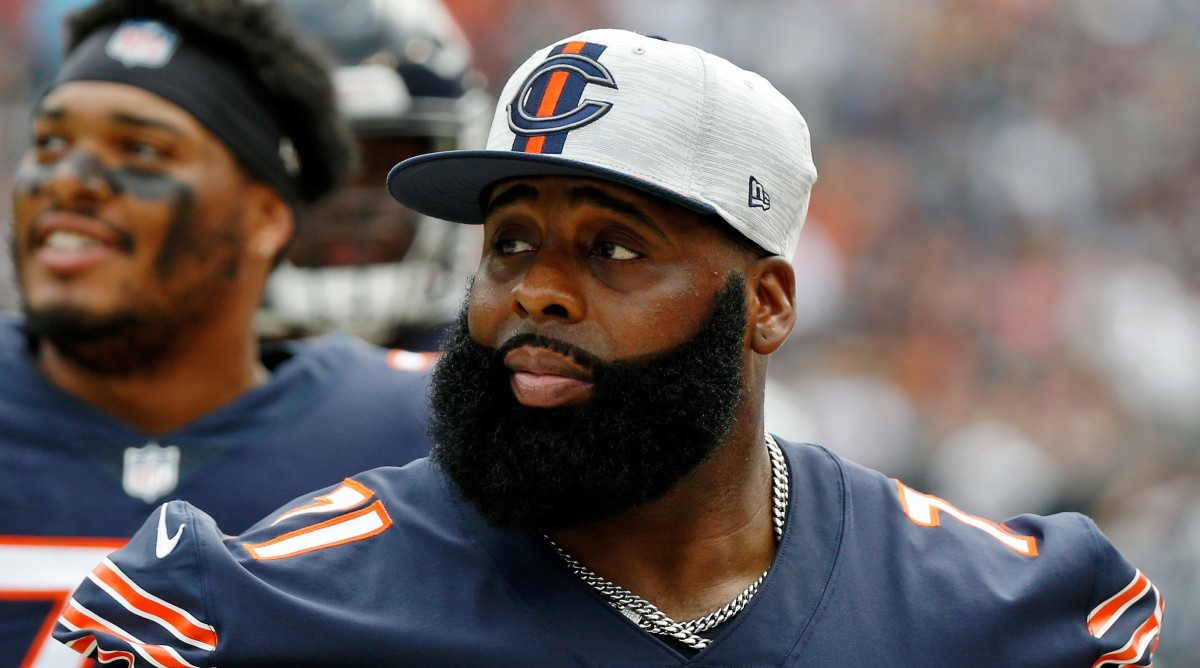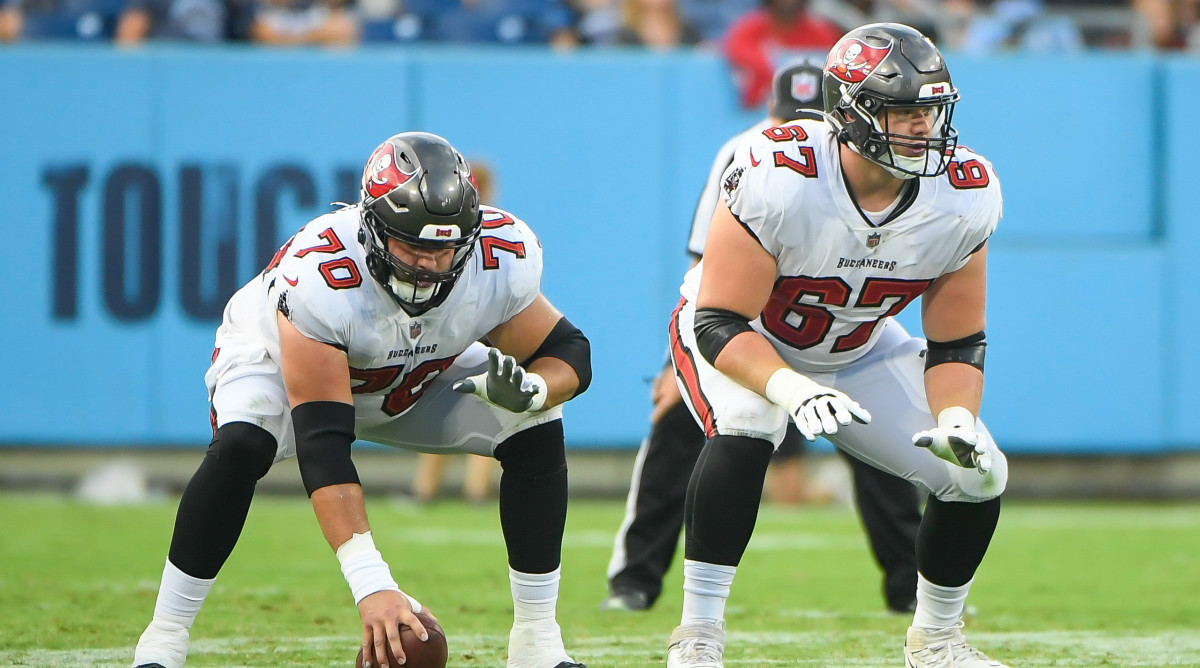MAQB: Cowboys’ Peters Signing Speaks to NFL’s Problem in the Trenches
Game week is here. We’re ready to roll …

Jason Peters is a Cowboy, and his signing makes him one of just two 40-something non-specialists currently in the league (I think you can guess the other one, and 49ers P Andy Lee, for what it’s worth, is also on the wrong side of 40). Last year’s Super Bowl champion had a guy in that category: Andrew Whitworth at left tackle. None of this is an accident.
The NFL’s got an issue developing offensive linemen, and it’s not a new one. It’s why four backup linemen were traded in the last two weeks. It’s why linemen are routinely the ones getting claimed on waivers. It’s why the offensive line coach has become maybe the third-most valuable assistant on any head coach’s staff, behind the offensive and defensive coordinators who set his schemes.
The reasons for it are twofold.
First, as much as NFL schemes creep toward what’s done in college, with concepts now consistently trickling up from that level to the pros, there’s still a pretty big difference in how offense is played at the two levels. So a lot of what you need to see on a college player’s tape at center, guard and tackle, you really don’t see.
“A lot of it comes from the fact that offenses in college are so different than the NFL,” one NFC exec said. “Guys don’t have the skill set to be ready to play early on, and some of them never wind up developing it.”
What can help, the exec continued, is if a team has a line coach who’s specific with traits he needs in his linemen—so scouts can be more certain there’s something to be developed. Which helps explains the success teams like Kansas City (Andy Heck’s been there for all 10 of Andy Reid’s years) and New England (with Dante Scarnecchia up until 2019) have had in bringing their own along.
The second element here is the practice rules. In 2011, with the elimination of two-a-days and all but 14 padded practices in-season, there are very few full-speed opportunities in which to develop young offensive linemen. And at those positions, backups don’t play in games (teams don’t rotate offensive linemen, generally, like they do defensive linemen) so those guys can go the whole season without seeing much contact at all. As a result, it’s tough to develop them, which compounds the issue of their readiness coming out of college.
Which is why guys who are fully developed, experienced linemen keep getting chances well into their 30s and even into their 40s—and why teams are usually slower to say good bye to aging linemen whose bodies start betraying them.
So maybe Peters works out in Dallas, maybe he doesn’t. Either way, given where the NFL is right now in this area, it’s hard to blame the Cowboys for taking the swing.
• So how much does Peters have left for Dallas? They’ll find out by getting him on the practice squad and seeing where he is physically. But this one’s a little complicated. First of all, Peters needs be managed through the year, which is understandable given his age, so he probably won’t be practicing much (making the fact that he’s on the practice squad kind of funny). Second, at this point, it’d be tough to rely on him to play a position other than the one he’s played for a decade-and-a-half.
That means if he shows he’s still got it, it’d make sense to roll him out there at left tackle and have rookie Tyler Smith start out at guard to try and get your best combination of five on the field. And the truth is, talented as Smith is (he’s got a boatload of ability), the knock on him coming out of Tulsa was that he was pretty raw. So another benefit of having him at guard rather than left tackle to begin with is that the lumps he does take won’t be as visible.
I also think Peters, if he’s willing, could be a really good mentor for Smith, given that Peters himself had a lot to learn about playing left tackle after coming into the league and making the switch over from tight end, where he played in college and initially for Buffalo.
• No one should be surprised that Mike Kafka landed play-calling duties with the Giants—because without knowing there was a shot of that happening, he probably wasn’t leaving the Chiefs. And in Kansas City, he would’ve been offensive coordinator already had Eric Bieniemy landed a job somewhere else over the last few years. Kansas City had blocked Kafka from leaving before, when it was still within the rules to do so, because Andy Reid really valued Kafka (and believed he’d become a head coach within a few years).
So yes, Kafka had an idea he could be the play-caller when Brian Daboll offered him the Giants job. And that combined with the opportunity to learn Daboll’s offense, and tie in some of the things he learned working for Reid in Kansas City and even playing for him in Philly, was enough to lure the 35-yard-old away from Reid and Patrick Mahomes.
As for the Giants, there’s a lot of work to be done on the roster, but what the offense becomes as that roster gets re-stocked the next couple of years should be really interesting.
• It’s hard not to tie in Mitch Trubisky’s election as a Steelers captain to where he stands in the quarterback competition (one that’s almost certainly over at this point, even if its results have yet to be disclosed). The truth is that while players do vote on these things, head coaches routinely retain the right to adjust the final tally in order to get the best result for the team. So my guess is this is a soft opening to Mike Tomlin’s eventual announcement.

• The Buccaneers’ line situation, obviously, bears watching. Tampa’s going to have three new starters at the interior positions, and early on rookie left guard Luke Goedeke will be the one to watch. He converted from tight end to right tackle in college, and every game he started at that level was at that spot. The Bucs, among others, projected him to guard as a pro, and he’s got a lot of promise to make it there.
But making that transition as a rookie might not be automatic, with how fast things happen inside in the NFL. Having a veteran center, like Ryan Jensen, would help. But with Jensen out until at least the playoffs, Goedeke won’t have that benefit either—with Tampa’s new center, second-year man Robert Hainsey, also set to make his first start in the opener.
I’m not projecting this is going to be a disaster, to be clear. It just bears watching. And it’ll be interesting, too, to see how other teams try to attack the middle of the Bucs’ line, with the book on Tom Brady to begin with being that bringing inside pressure against him gives you the best chance.
• You all will see my awards predictions a little later in the week. But there were a few where I wanted to stick my neck out a little, and just didn’t have the stomach for it. So I pocketed those with the idea I’d do a dark-horse list of awards candidates at some point, and this seems like a good time for it. And again, these aren’t my picks—these are the guys that, honestly, I sort of wanted to pick but didn’t have the stomach to.
MVP: Derek Carr, Raiders
OPOY: Brandon Aiyuk, 49ers
DPOY: Rashan Gary, Packers/Patrick Surtain, Broncos
OROY: Isiah Pacheco, Chiefs
DROY: Coby Bryant, Seahawks
Coach: Kevin O’Connell, Vikings
Comeback Player: J.K. Dobbins, Ravens
• And while we’re here, we can empty out the notebook from my camp trip with a few impressions I had hiding in there. We can start with a couple of trends I noticed with rookies on the defensive side of the ball.
The first was not just how many Georgia guys are out there (that much is obvious) but how their teams talk about them. I had one staffer in Green Bay point out that more than just seeing that first-rounders Quay Walker and Devonte Wyatt were ready to play right away, the Packers knew it’d be that way—because of their experience last year seeing Eric Stokes thrust into a No. 1 corner role after Jaire Alexander went down. The guy went on to tell me that, at this point, when you draft a Georgia defender, you know what you’re getting.
That’s the way teams have talked about Alabama defenders for years (makes sense, too, since Kirby Smart worked for Nick Saban). It also bodes well for guys like Jalen Carter, Kelee Ringo and Nolan Smith next year.
The second one was that at a string of camps, products of Luke Fickell’s Cincinnati program would come up as players that were pleasant surprises. Bryant in Seattle was one. Safety Bryan Cook in Kansas City was another. And then you have Sauce Gardner, whose solid play isn’t really a surprise (he was the fourth pick in the draft), and Colts wideout Alec Pierce, who’s obviously on offense, and it seems like Fickell’s doing a pretty good job of developing pros up there.
• The Chargers receiver situation should be really interesting. We mentioned from camp that second-year wideout Josh Palmer has a real chance to break through this year, and how a big part of it would be his inside-out versatility. At the same time, you hear Mike Williams, coming back with a new contract, has really rounded out his game and become more of a complete receiver.
So what Joe Lombardi does with these big, imposing moveable pieces (don’t forget Keenan Allen, who’s at a baseline one of the NFL’s most polished, complete receivers) in a Sean Payton-styled scheme should be really interesting. And with Justin Herbert in place to unlock of all this? Look out.
• Greg Rousseau could be one name worth watching that’s fallen a little under the radar. This offseason, he really worked to change his body composition, and came back physically looking a little different. And he just turned 22 in April. So add that to the influence Von Miller will have on him and the depth the Bills have (Boogie Basham, A.J. Epenesa) at end to keep guys’ legs free, and it’s easy to see why Buffalo’s optimistic a jump is coming.
• Pat Freiermuth should be another second-year guy to watch. I was with the Steelers early in camp, and he was catching everything at that point. It hasn’t stopped since. So I think he’s poised for a breakthrough season, and I wouldn’t be shocked if, a year from now, we’re talking about him in the upper echelon of tight ends.
• Three days to go … Can’t believe it’s here.
More NFL Coverage:
- MMQB: Joe Burrow Doesn’t Have All the Answers, but He’s Close
- Predicting Every Game of the 2022 NFL Season
- AFC West Preview and Predictions: They’re All Coming for the Chiefs
- NFC North Preview and Predictions: Behind the Pack, a Dark Horse Could Emerge
- AFC South Preview and Predictions: Henry’s Titans Look to Stay Ahead of Indy
- AFC East Preview and Predictions: It’s Buffalo’s World Now
